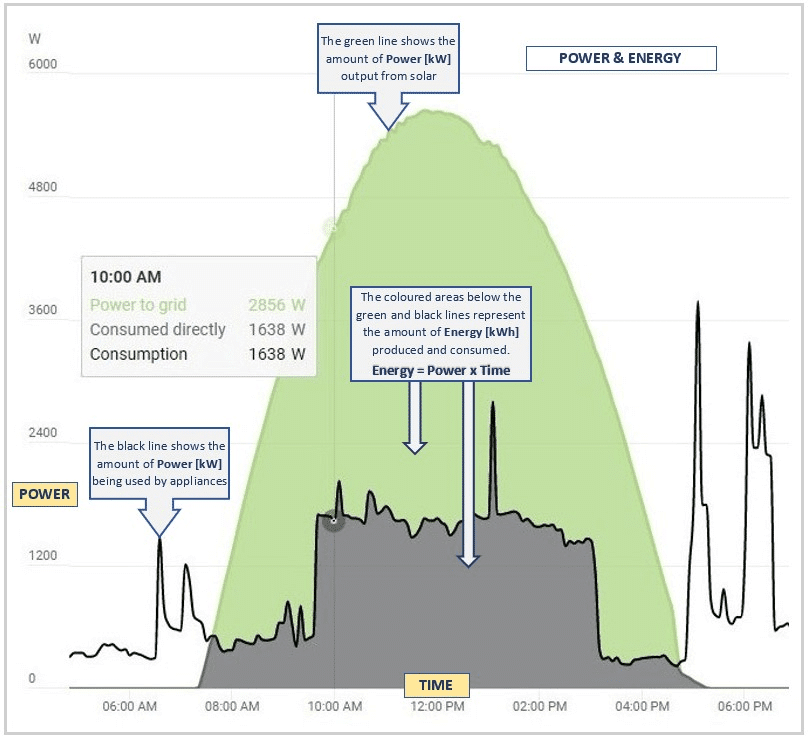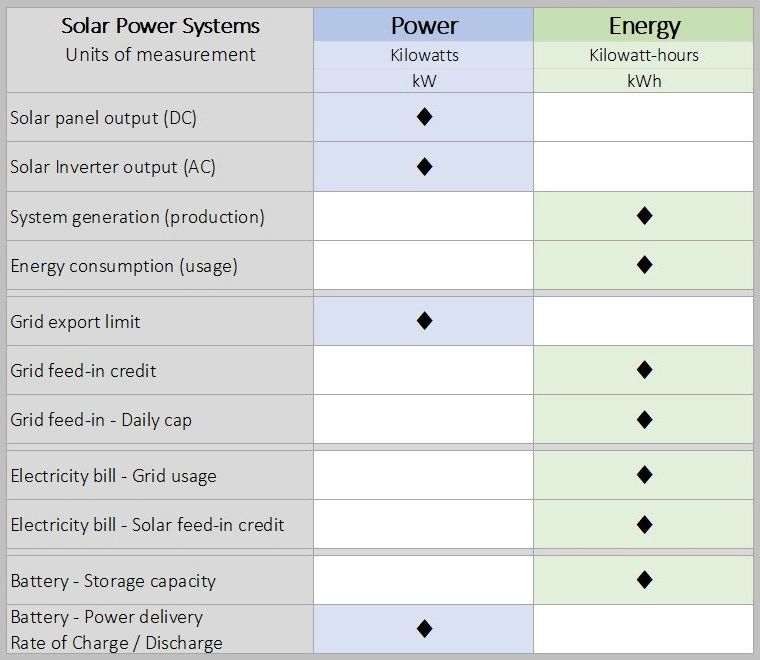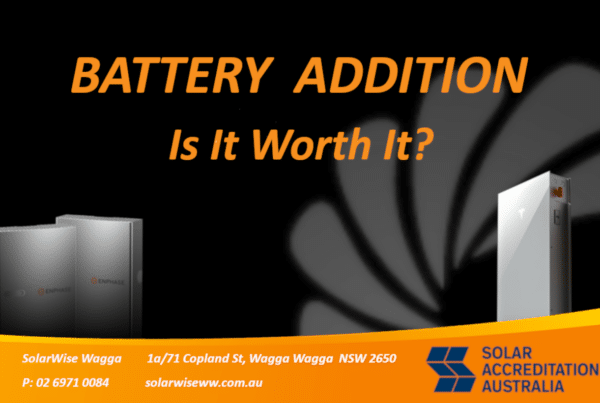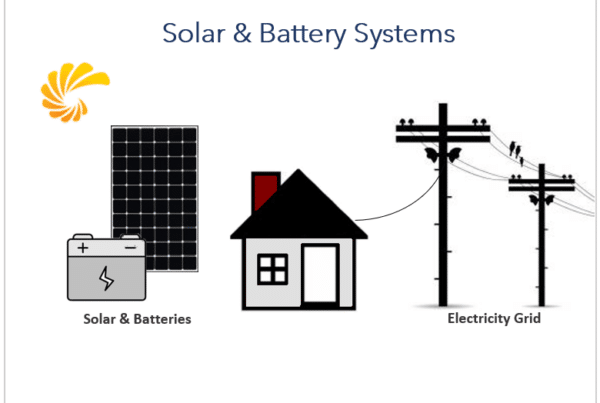Solar Power Systems
Power & Energy • System Monitoring • Electricity Bills.
With regard to solar power systems, there are a number of aspects of power & energy measurement, system monitoring, and electricity billing which can sometimes cause confusion or that aren’t always widely understood.
The purpose of this article is to explain some of these with the aim of helping avoid some common mix-ups, misunderstandings, or misinterpretations.

Topics covered in the sections of this article include:
- The difference between Power & Energy
- Power and Energy measurement in solar power systems
- How Power & Energy relate to Efficiency & Performance
- How electrical energy flows in a grid connected solar power system
- Prioritisation of energy production & consumption
- Measurement units and terminology used with solar power systems
- What your electricity bill can and can’t tell you
Power and Energy
Power and energy are often mistaken as being the same, when in fact they are quite different.
Understanding the difference and knowing what each one means is important.
Energy is defined as the amount of work performed.
Power is defined as the rate at which work is performed.
Energy is measured in Joules ( J )
Power is measured in Watts ( W )
1 Watt = 1 Joule per second ( J/s ) = a rate of energy transfer of 1 Joule every second.
Although the Joule is the SI unit for energy, it is more common to use kilowatt-hour (kWh) for units of energy measurement because a joule is an extremely small amount of energy.
Therefore, in electrical systems energy is measured in Watt-hours (Wh).
For solar and grid electricity we add the kilo multiplier, so we have kilowatts [kW] and kilowatt-hours [kWh].
1 kWh = 3600000 joules (3600 kilojoules) = approx. 3 McDonalds Cheeseburgers.
![]()
So, here’s what we need to know:
kW is a measurement of Power – the rate at which energy is transmitted, generated, or consumed.
kWh is a measurement of Energy – the amount of work done over time
Energy [kWh] = Power [kW] x Time in hours [h]
Examples:
1) If a solar power system had a constant power output 3 kW for 2 hours, it produced 6 kWh of energy.
2) If a 2.4 kW heater operates for 4 hours, it will consume 9.6 kWh of energy.
The energy graph used to create the diagram above was captured from the Fronius SolarWeb energy monitoring portal which shows production & consumption data from a system owned by one of our customers.
System Efficiency & Performance
The terms efficiency and performance are often associated with solar power systems and their inverter & panel components.
Generally speaking, in terms of solar power systems:
– Efficiency relates to power output
– Performance relates to energy generation
Thus, the performance of a system will vary with changes in efficiency,
because energy varies with changes in power (Energy = Power x Time)
There are numerous factors that affect the efficiency of a solar power system.
Some factors are built in to the system.
– E.g. Panel and Inverter technology, certain aspects of system design.
Other factors are variable, and will change with conditions or time.
– E.g. operating temperature, panel degradation.
![]() A high-performance system will have a higher initial investment cost; however, it will generate more Energy (kWh) than a system with cheaper panel & inverter technology, even with the same amount of power (kW) capacity.
A high-performance system will have a higher initial investment cost; however, it will generate more Energy (kWh) than a system with cheaper panel & inverter technology, even with the same amount of power (kW) capacity.
High-end systems will therefore provide a better return over time.
Energy Flow - How solar generated energy is used
The energy supplied by a solar power system will be used in two ways:
1. Consumed directly to supply electricity used within the property – offsetting the cost of electricity which would have otherwise been purchased (imported) from the grid.
2. Surplus electricity production will be sold to the grid (exported) – credit for exported energy is applied to the electricity account.
The energy produced from solar that is used directly in the home at the time it is generated is referred to as self-consumed.
The ratio of self-consumed and exported solar production will vary due to several factors, for example:
• seasonal variations in energy production & consumption
• the electrical appliances in use (heating/cooling, pool pumps, etc)
• the solar system output capacity relative to average energy usage
The percentage of total solar production that is used directly in the home as it is generated is often referred to
as solar self-consumption rate. (e.g. 60% Self-consumption – 40% Exported)
Increasing the self-consumption rate will provide an increase in savings and a reduction in system payback time.
In the above scenario, the level of solar energy generation is greater than the energy being consumed by appliances.
100% of the energy being used is supplied by solar, with surplus energy being sent to the grid for credit.
Energy Flow – Prioritisation
When energy is generated by solar power, or consumed by appliances, there is prioritisation that takes place within the system.
For energy generated, the normal order of priority is supply to:
Appliances → Battery storage → Energy diversion → Exported to Grid.
For energy consumed, the normal order of priority is source from:
Solar production → Battery storage → Imported from Grid.
Systems with batteries or energy diverters installed sometimes have functionality that allow advanced settings that give extra control over energy flow.
For example:
– Some battery systems can be programmed to keep a certain level of energy in reserve, so that it will always be available in the event of a blackout.
– Some batteries can be programmed for time of use tariffs (TOU) so they will charge from the grid during off-peak times and discharge to supply energy during the peak tariff time period.
Solar Energy Production | Energy Consumption | Solar Export | Energy Import
When analysing energy monitoring data, it is important to be aware of the different terms and energy measurements that are used, understand their meaning, and know how they are measured.
The fundamental energy measurement values for a grid connected system without battery storage are:
• Solar Production – the total energy generated by the system.
• Energy Consumption – the total energy consumed by the property, sourced from solar & grid.
• Energy Exported – Surplus energy that isn’t consumed directly is sent to the grid.
• Energy Imported – Energy imported from the grid to supply consumption that cannot be supplied directly from solar.
Other terms sometimes used have values derived from mathematical relationships between the above measurements. (e.g. Energy Balance, Net Energy)
Systems that include energy storage batteries or energy diverters will have additional measurements and data values.
The chart below shows which parts of the system are used for measuring different energy values.
Click image to view larger.
What your electricity bill can and can’t tell you
The energy data used for an electricity bill is obtained from the main electricity meter which can only measure energy going in and out at the grid interface (imported & exported energy). It cannot measure the total energy generation that has been produced by the system, or the amount of energy consumed by appliances that was supplied directly from solar generation.
Because the main electricity meter records only a part of the complete system data, and an electricity bill can only report on energy that was imported or exported, this can lead to misinterpretation of a system’s performance or effectiveness.
In some cases, data from an Energy Retailer’s monitoring App refers to the imported energy as consumption and the energy exported as production.
While it is true that energy imported from the grid is consumption, and energy exported is production, they amount to only a portion of the total consumption & production.
Alternative terms could be used to describe these partial consumption & production values. For example; grid-consumption & production credit, or similar.
When generating your electricity bill, Energy Retailers only use the data for imported & exported energy that is available from the main electricity meter. Recorded data from integrated system monitoring is not normally available to energy retailers, and is not used for billing purposes.
![]() Electricity bills and electricity smart meter data apps can only tell part of the story, only full system monitoring can provide a complete picture of what is happening with energy production & consumption in a system.
Electricity bills and electricity smart meter data apps can only tell part of the story, only full system monitoring can provide a complete picture of what is happening with energy production & consumption in a system.
Make an Enquiry

“At SolarWise Wagga our philosophy is simple, we aim to provide relevant and reliable information, quality service, and the highest grade of products at a competitive price.”
Request a free Quote today!










